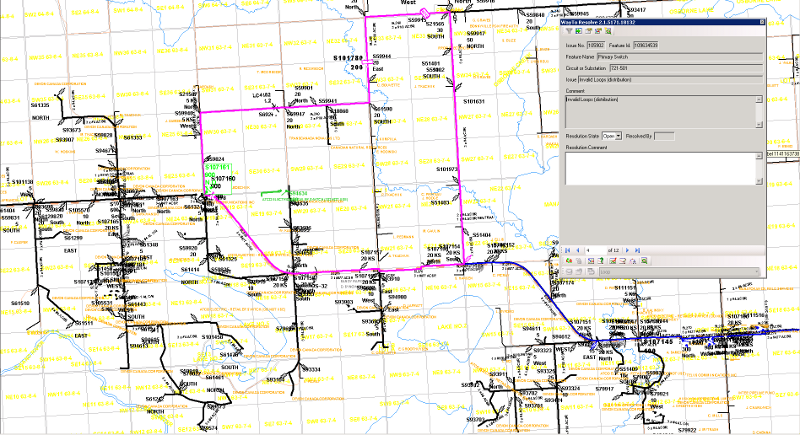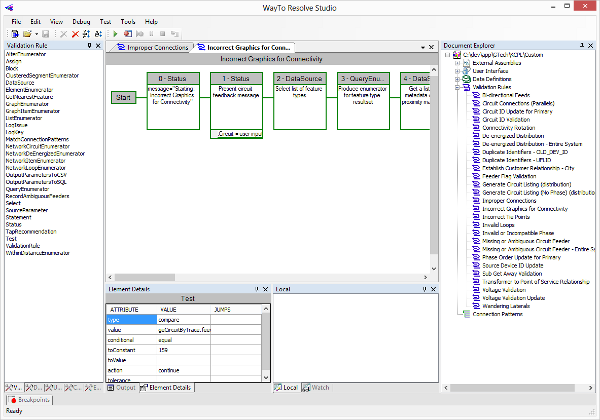
All business processes rely on the availability of good data to operate smoothly. When errors appear in data, a normal business process is sidetracked, requiring the enterprise to consume more resources. Each individual instance appears small, but when annualized, the costs can be quite high. One example is a small utility that had about 15% of the services incorrectly positioned or not recorded within their GIS. The impact on just one Outage Management process results in an annual cost of around $100,000. WayToResolve is intended to detect the errors, provide potential resolutions, and provide information to analyze the source of errors. Once the source and volume are determined, the particular processes can be modified to eliminate the source of the error.
The existence of defects can be tracked to a few processes. The largest number likely came from conversion from paper and subsequent migrations to alternate GIS implementations. Original conversions from paper occurred mainly in Computer Aided Drafting systems. Geometries were subsequently migrated to more intelligent systems, along with the capture of attribution. Defects may have existed in the original paper sources. The manual processes of conversion may have introduced some additional errors, particularly connectivity issues. These errors and others were maintained or introduced by subsequent migration processes.
Finally, and the reason for an on-going health check, is that operational processes introduce defects on an ongoing basis.
WayToResolve consists of a processing core, a "Rules" file, and support for externally defined libraries for custom and client-specific detection. There is also a facility provided to create and modify rules in the XML Rules file, and a dashboard to review Quality Statistics. In the case of G/Technologies based models, a custom command within a G/Designer or a G/Administrator seat guides the user through the resolution of each issue. For issues where the count is relatively low, the queued edit mechanism is an effective technique. For higher volume issues, the queued edit function acts as an analysis capability to define an automated process to resolve the issues.




There are a number of issues that could be implemented with a minimal effort, as a template would exist for the following issues:
The introduction of connectivity issues bring about a situation where a feature or group of features are not fed by any breaker in the system.
Identify all features that are connected that should not be.
Identify features fed from multiple sources. These could be features fed from multiple breakers or multiple paths to a feature.
Verify all switchable devices for closed connections to multiple circuits.
Identify Connections between Overhead and Underground that are NOT through valid features. E.g. OH Conductor to UG Conductor.
Verify that all conductor phase connections are valid.
Identify features where the circuit id does not match the breaker it is connected to.
This would be a set of rules to check the Underground and Overhead systems to confirm that they are appropriately set.
Features may have attribution which is conflicting.
Identify features where features have no ownership relationships or are owned by features that are not valid "parents".
Identify locations where a protective device is incorrectly located in-line on the main line instead of protecting the tap line.
These issues can be detected across the entire network, or filtered and executed on subsets (e.g. by Transmission/Distribution/etc., circuit number, service area). The defects are stored in the database, and using the WayToResolve Custom command in a G/Designer seat, the user is able to visit each issue. Facilities are available to in the analysis of the defect and tools to ease the remediation. Some issues definitions permit the user to review the suggested solution based on a pattern, then accept or reject the suggestion. All resolutions are performed with the context of a "job". Thus the changes are not permanently made to the model until they are posted. Posting can be done with or without validation.
WayToResolve is intended to standardize the process of detecting defects in a data source. By implementing this product and methodology, an enterprise should have the ability not only to rectify the issues economically, but also implement a strategy for process improvement. When certain defects are increasing, the culprit could be a flaw in a placement/edit function or a lack of understanding of the function. A change could be requested in the placement function (technical resolution), or staff could be re-trained (operational resolution). If defects crop up in one district and not another, then it automatically points to re-training just to the district where problems are on the increase.
The product and methodology is particularly well suited to integration projects. The holy grail has always been an "enter once, use frequently" approach to data management. However, when updates are widely distributed, defects can increase. Centralizing updates has been the control mechanism, however, central updates usually negate the business benefits of update at source.
Please contact WayTo for purchase details.
© 2025 WayTo Integration and Consulting Services Inc. All Rights Reserved. | Products | Services | Careers | Contact Us